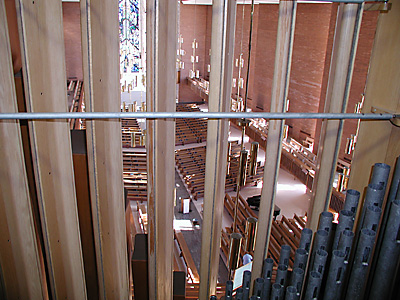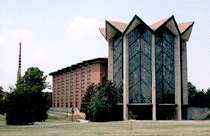 |
||||||||||||||||||||||||||||||||||||||||||||||||||||||||||||||||||||||||||||||||||||||||||||||||||||||||||||||||||||||||||||||||||||||||||||||||||||||||||||||||||||||||||||||||||||||||||||||||||||||||||||||||||||||||||||||||||||||||||||||||||||||||||||||||||||||||||||||||||||||||||||||||||||||||||||||||||||||||||||||||||||||||||||||||||||||||||||||||||||||||||||||||||||||||||||||||||||||||||||||||||||||||||||||||||||||||||||||||||||||||||||||||||||||||||||||||||||||||||||||||||||||||||||||||||||||||||||||||||||||||||||||||||||||||||||||||||||||||||||||||||||||||||||||||||||||||||||||||||||||||||||||||||||||||||||||||||||||||||||||||||||||||||||||||||||||||||||||||||||||||||||||||||||||||||
 |

Valparaiso University
Chapel of the Resurrection Valparaiso University, a Lutheran liberal arts institution, was founded in 1859. Under the dynamic leadership of Pres. O. P. Kretzmann, the University commissioned Buffalo, New York organbuilder Herman Schlicker to construct an organ for its recently completed chapel. A contract for the organ was signed on September 27, 1957 at a cost of $68,000. These funds paid for about three-quarters of the entire specification, the price of which would have been $98,000. Paul Bunjes of Concordia College, River Forest, Illinois, was retained as consultant. The instrument was dedicated at the morning Eucharist on September 27, 1959, and was featured that evening in a recital by E. Power Biggs to a record audience of over 2,000 people. The famous collaboration between Schlicker and Bunjes resulted in a revolutionary and ground-breaking design for the organ. The instrument was an early example of Neo-Classic organ building, based on the then-novel Werkprinzip concept. The organ was the only American organ to be featured in the 14th edition of the Encyclopedia Brittanica, and most of the great concert organists of our time have performed on it. Three purposes guided the building and design of this instrument: first, that it be a fitting leader for liturgical worship; second, that it faithfully accommodate a wide variety of organ literature in recital (particularly the music of Bach and his contemporaries); and finally, that it be a useful teaching instrument. It has been exemplary in all three respects throughout its many years of service. Naturally enough, these years have taken their toll on the instrument. Furthermore, the fact that the organ had never been completed began to cause concern for its future as a pre-eminent teaching and recital instrument. By 1992 these concerns resulted in feasibility studies of its completion and restoration conducted by Jack Bethards and Lynn Dobson. As a result, on May 25, 1994, a contract was signed with the Dobson Pipe Organ Builders of Lake City, Iowa to refurbish and complete the instrument. Our work included the complete releathering of the organ, construction of an entirely new console to a design that honored Schlicker’s original while accommodating new features, installation of a new solid state electrical system, reconfiguration of the placement of the Great and Pedal chests, repair of the façade pipes with additional racking to better support them, and construction and voicing of new pipes and the necessary windchests to complete the organ. That Schlicker’s original tonal design should be respected was a guiding principle; nevertheless, some revoicing was undertaken to correct speech or to improve the balance between stops. With the addition of 29 new ranks of pipes, the organ is now complete. The original specification called for several new flutes to be added to Great and Pedal, completion of the reed choruses in both of those divisions and the addition of a number of mutations so that each division now has a complete cornet. Some significant modifications were made to the Schlicker/Bunjes design. Instead of two soft 4’ reeds in Swell and Positiv, and Vox Humana and French Cromorne were substituted, respectively. More 8' sound seemed necessary, so the Salicional and Principal 8' were added to these divisions as well, taking the place of the envisioned Schwegelschwebung II (a 4' celeste) and an Quintadena 8', respectively. Originally, the fourth division was to be a Brustwerk based on a Principal 2'; however, an expressive Solo divisions was put in its place. The instrument was re-dedicated at the morning Eucharist on September 15, 1996, and was featured that afternoon in a recital by John Scott, Organist and Director of Music at St. Paul’s Cathedral in London, to an audience of over 2,000 people, echoing the record crowd of the 1959 dedication.
Schlicker Organ Company, 1959 Dobson Pipe Organ Builders, 1996
|
|||||||||||||||||||||||||||||||||||||||||||||||||||||||||||||||||||||||||||||||||||||||||||||||||||||||||||||||||||||||||||||||||||||||||||||||||||||||||||||||||||||||||||||||||||||||||||||||||||||||||||||||||||||||||||||||||||||||||||||||||||||||||||||||||||||||||||||||||||||||||||||||||||||||||||||||||||||||||||||||||||||||||||||||||||||||||||||||||||||||||||||||||||||||||||||||||||||||||||||||||||||||||||||||||||||||||||||||||||||||||||||||||||||||||||||||||||||||||||||||||||||||||||||||||||||||||||||||||||||||||||||||||||||||||||||||||||||||||||||||||||||||||||||||||||||||||||||||||||||||||||||||||||||||||||||||||||||||||||||||||||||||||||||||||||||||||||||||||||||||||||||||||||||||||
 |
||||||||||||||||||||||||||||||||||||||||||||||||||||||||||||||||||||||||||||||||||||||||||||||||||||||||||||||||||||||||||||||||||||||||||||||||||||||||||||||||||||||||||||||||||||||||||||||||||||||||||||||||||||||||||||||||||||||||||||||||||||||||||||||||||||||||||||||||||||||||||||||||||||||||||||||||||||||||||||||||||||||||||||||||||||||||||||||||||||||||||||||||||||||||||||||||||||||||||||||||||||||||||||||||||||||||||||||||||||||||||||||||||||||||||||||||||||||||||||||||||||||||||||||||||||||||||||||||||||||||||||||||||||||||||||||||||||||||||||||||||||||||||||||||||||||||||||||||||||||||||||||||||||||||||||||||||||||||||||||||||||||||||||||||||||||||||||||||||||||||||||||||||||||||||
|
View of the chapel through the Swell II expression shades.
Photo courtesy Paul Serresseque |
||||||||||||||||||||||||||||||||||||||||||||||||||||||||||||||||||||||||||||||||||||||||||||||||||||||||||||||||||||||||||||||||||||||||||||||||||||||||||||||||||||||||||||||||||||||||||||||||||||||||||||||||||||||||||||||||||||||||||||||||||||||||||||||||||||||||||||||||||||||||||||||||||||||||||||||||||||||||||||||||||||||||||||||||||||||||||||||||||||||||||||||||||||||||||||||||||||||||||||||||||||||||||||||||||||||||||||||||||||||||||||||||||||||||||||||||||||||||||||||||||||||||||||||||||||||||||||||||||||||||||||||||||||||||||||||||||||||||||||||||||||||||||||||||||||||||||||||||||||||||||||||||||||||||||||||||||||||||||||||||||||||||||||||||||||||||||||||||||||||||||||||||||||||||||
 |
||||||||||||||||||||||||||||||||||||||||||||||||||||||||||||||||||||||||||||||||||||||||||||||||||||||||||||||||||||||||||||||||||||||||||||||||||||||||||||||||||||||||||||||||||||||||||||||||||||||||||||||||||||||||||||||||||||||||||||||||||||||||||||||||||||||||||||||||||||||||||||||||||||||||||||||||||||||||||||||||||||||||||||||||||||||||||||||||||||||||||||||||||||||||||||||||||||||||||||||||||||||||||||||||||||||||||||||||||||||||||||||||||||||||||||||||||||||||||||||||||||||||||||||||||||||||||||||||||||||||||||||||||||||||||||||||||||||||||||||||||||||||||||||||||||||||||||||||||||||||||||||||||||||||||||||||||||||||||||||||||||||||||||||||||||||||||||||||||||||||||||||||||||||||||
|
Our Shop • Instruments • Recordings • Testimonials Dobson Pipe Organ Builders, Ltd. Site conception by metaglyph All contents ©1999–2016 Dobson Pipe Organ Builders, Ltd. |
||||||||||||||||||||||||||||||||||||||||||||||||||||||||||||||||||||||||||||||||||||||||||||||||||||||||||||||||||||||||||||||||||||||||||||||||||||||||||||||||||||||||||||||||||||||||||||||||||||||||||||||||||||||||||||||||||||||||||||||||||||||||||||||||||||||||||||||||||||||||||||||||||||||||||||||||||||||||||||||||||||||||||||||||||||||||||||||||||||||||||||||||||||||||||||||||||||||||||||||||||||||||||||||||||||||||||||||||||||||||||||||||||||||||||||||||||||||||||||||||||||||||||||||||||||||||||||||||||||||||||||||||||||||||||||||||||||||||||||||||||||||||||||||||||||||||||||||||||||||||||||||||||||||||||||||||||||||||||||||||||||||||||||||||||||||||||||||||||||||||||||||||||||||||||



